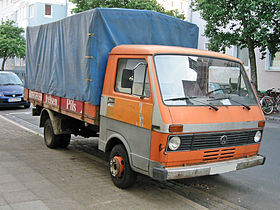Volkswagen LT
| Volkswagen LT | |
|---|---|
 |
|
| Overview | |
| Manufacturer | initially: Volkswagen, later: Volkswagen Commercial Vehicles |
| Production |
Typ 28: April 1975–July 1991 Typ 21: August 1991–December 1995 Typ 2D: May 1996–July 2006 |
| Body and chassis | |
| Class | Light commercial vehicle |
| Body style | Van (Cargo/Passenger), Pickup, Minibus, Crew cab, Chassis cab |
| Layout |
Front engine, rear-wheel drive or four-wheel drive |
| Platform | Volkswagen Group LT/T1N series |
| Chronology | |
| Successor | Volkswagen Crafter |
| Volkswagen LT (1st generation) | |
|---|---|
 |
|
| Overview | |
| Manufacturer | Volkswagen |
| Also called | LT 28, LT 31, LT 35, LT 40, LT 45, LT 50, LT 55 |
| Production | April 1975–December 1995 |
| Assembly | Hannover |
| Powertrain | |
| Engine |
Petrol: 2.0 L I4 (1975-1982) 2.4 L I6 (1983-1996) Diesel: 2.7 L Perkins I4 (1976-1977) 2.4 L D24 I6 (1978-1996) 2.4 L D24T turbo I6 (1983-1992) 2.4 L D24TIC turbo I6 (1993-1996) |
| Transmission | 4-speed manual 5-speed dog-leg manual |
| Dimensions | |
| Wheelbase | Short: 2500mm, Long: 2950mm, Super Long: 3650mm |
| Width |
2.085 m (6 ft 10.1 in) (panelvan/pickup-chassis/doka-chassis) 2.14 m (7 ft 0.3 in) (flatbed-pickup/flatbed-doka) |
| Volkswagen LT (2nd generation) | |
|---|---|
 |
|
| Overview | |
| Manufacturer | Volkswagen Commercial Vehicles |
| Production | May 1996–July 2006 |
| Chronology | |
| Successor | Volkswagen Crafter |
The Volkswagen LT was the largest light commercial vehicle panel van produced by Volkswagen (and subsequently Volkswagen Commercial Vehicles as of 1996) from 1975 to 2006. Two generations were produced.
2.085 m (6 ft 10.1 in) (panelvan/pickup-chassis/doka-chassis)
Volkswagen introduced the Volkswagen Type 2 in 1950 and developed light commercial vehicle versions for German and European markets. The name "Kombi" (the name under which the Type 2 was sold in Brazil) established itself as a concept term to describe an entire light commercial vehicle segment. The automaker introduced the revised Volkswagen Type 2 (T2) in 1968. Commercial customers were shipping heavier and larger-volume freight. The Volkswagen Type 2 platform was also limited by its rear-mounted engine design.
The new design specifications for a larger transporter as an additional series ranged from 2.8 tons gross vehicle weight to 3.5 tons. The layout was a conventional rear drive with the engine located above the front axle, in a forward control or 'cab over' design.
The new Volkswagen van was launched in 1975 in Berlin. The name given to Volkswagen's large transporter was as functional as the entire vehicle: it was just called LT, which is simply the abbreviation of Lasten-Transporter (or cargo transporter).
The LT came in three gross vehicle weights, from 2.8 to 3.5 tons (LT 28, LT 31, LT 35), with two wheelbases, two roof options, and with bodywork options as a panel van, a compact, a platform vehicle and a chassis cab combination.
...
Wikipedia
